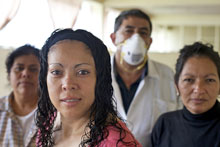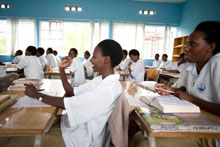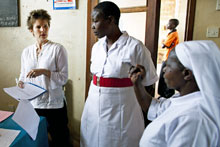
Refining What It Means to Measure Health Workforce Progress
As providers of lifesaving care to communities in need, health workers play a crucial role in efforts to improve global health. In monitoring and evaluation (M&E) of global health programs, it can be challenging to measure health workforce progress and demonstrate the impact of health workforce interventions on health outcomes.
On May 16 at the USAID Bureau of Global Health Cooperating Agencies M&E Working Group Spring Meeting, CapacityPlus’s Sara Pacqué-Margolis led a presentation on M&E of Human Resources for Health (HRH), with USAID’s Lois Schaefer and Jessica Rose serving as co-leaders of the session and discussion. Pacqué-Margolis provided an overview of conceptual frameworks and indicators currently being used to monitor health workforce outputs and outcomes, and described efforts to monitor production of new health workers toward PEPFAR’s target of 140,000 new health workers. Conceptual frameworks and indicators
Conceptual frameworks and indicators
The Health Worker Density Ratio, a measure of health worker availability, is calculated by the total number of doctors, nurses, and midwives in a country (or geographic area) divided by the total population in the country (or area), for a given period of time. The Health Workers Reach Index, developed by Save the Children, incorporates three measures—the Health Worker Density Ratio, the skilled birth attendance rate, and the DPT3 immunization rate. The latter two measures are derived from the Demographic and Health Survey.
The Health Workers Reach Index is a more valid indicator of access to health workers than the Health Worker Density Ratio because it incorporates population-based measures of use of services provided by health workers in addition to a measure of health worker availability. However, it too has limitations.
Participants discussed the level of measurement in terms of access to health workers versus health worker performance, and reflected on the data quality issues and trade-offs inherent in different measures. For example, the most valid measures might require a prohibitively expensive data collection format. Measuring PEPFAR’s target of 140,000 new health workers
Measuring PEPFAR’s target of 140,000 new health workers
The US government’s commitment to health workforce development is clearly reflected in PEPFAR’s reauthorization, which established a mandate to train and retain 140,000 new health workers. For PEPFAR country teams, contributing to and reporting on this new indicator has proven to be a challenge: they lacked a shared conceptual framework for defining production of new health workers; no existing standard indicator had been defined; and data sources were weak or nonexistent. Recognizing these challenges, the PEPFAR M&E and HRH Technical Working Groups asked CapacityPlus to develop tools and guidance to support country team efforts.
Participants were eager to learn more about the checklist PEPFAR is using to count the contribution of multiple preservice education inputs into the production of health workers (e.g., infrastructure, curriculum development, faculty support, tuition support, direct training, practica, materials, and equipment). While PEPFAR global health programs have struggled with defining and measuring the inputs and outputs of preservice interventions, there is now a systematic approach and model that advances the measurement of both the quantity and quality of preservice education in producing health workers toward the legislative target. Moving forward: What it takes to measure progress
Moving forward: What it takes to measure progress
According to participant Rachel Lucas, senior technical advisor in the Office of Population and Reproductive Health at USAID, the presentation “outlined a creative and intellectual process of coming to consensus on HRH concepts (within PEPFAR), developing a common conceptual framework, and developing standardized indicators in a field that is rapidly evolving.”
During the discussion, participants emphasized the value of gathering and using data on the health workforce. A major constraint in furthering advocacy for HRH is the lack of such data. Encouraging countries to collect and use quality data on the health workforce, through efforts to strengthen human resources information systems and build capacity to use data for planning and management, will be beneficial in making the case for continued attention to and investment in health workers.
Finally, participants discussed the challenges of being charged with demonstrating the impact of health workforce interventions on health outcomes, when working at the health systems level—this can be difficult to do in a limited time frame; other factors that determine health outcomes are outside HRH programs’ scopes; and impact evaluations can be costly.
Lucas noted, “This presentation reminded me that our health/development programs must be grounded in continuous and actionable learning, and that M&E is one crucial tool in this learning process.”
Related items:
Photos 1 and 3 by Trevor Snapp. (Health workers in Guatemala and Uganda)
Photo 2 by Christopher Wilson. (Health students in Rwanda)


